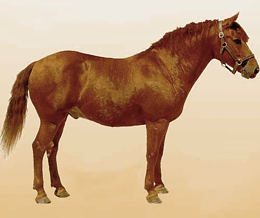
HORSES OF THE WORLD
| BASHKIR
Origin: |
 Photo supplied by Horse Directory Australia © |
History:
The small Bashkir originated in Bashkirsky on the southern foothills of
the Ural mountains, which gave the breed its name. It is one of the hardiest horse or pony
breeds and is well equipped to survive temperatures of -30* to -40*C (-20* to -30*
Fahrenheit) and severe blizzards in the open. The stocky built, strong bones and hard feet
enable the Bashkir to dig through snow a metre deep to find food. The breed is
traditionally kept in herds and used as pack, general work, harness and riding horse. The
locals also consume its meat and drink its milk.
Bashkir mares are famous for their milk production. During the lactation period of seven
to eight months a mare will produce approximately 1,500 litres (300 gallons) of milk. In
some areas horses are kept for their milk which is bottled and sold on a large scale.
There are also some Bashkir Horses in North America. It is believed that they were
introduced by the Spanish explorers. Its toughness enables the breed to adapt to less
severe climate conditions.
Characteristics:
stocky built
Head: massive
Neck: short, fleshy
Shoulders: low withers
Body: wide, deep body; broad, straight back; broad
chest
Legs: fairly short, strong limbs; great amount of bone
Feet: good, exceptionally hard; able to walk without being
shod
Mane, Tail and Coat: extremely thick
Color: predominantly bay, chestnut and brown
Height: 13.3. to 14hh
Temperament: good
Qualities: very tough, tremendously hardy, adaptable
Today:
In Russia Bashkirs are still used as a pack, harness, riding and general
work horses. In some areas horses are kept for their milk, which is sold in large
quantities to other regions.
![]()